七年级英语上学案4
人教版七年级英语上册全册学案
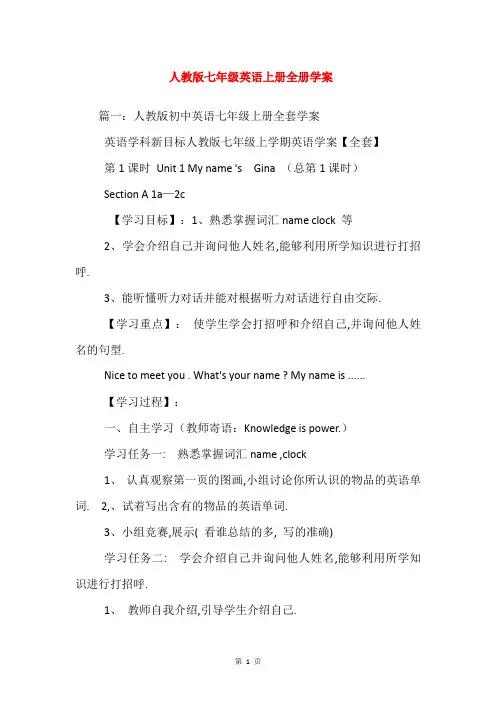
人教版七年级英语上册全册学案篇一:人教版初中英语七年级上册全套学案英语学科新目标人教版七年级上学期英语学案【全套】第1课时Unit 1 My name 's Gina (总第1课时)Section A 1a—2c【学习目标】:1、熟悉掌握词汇name clock 等2、学会介绍自己并询问他人姓名,能够利用所学知识进行打招呼.3、能听懂听力对话并能对根据听力对话进行自由交际.【学习重点】:使学生学会打招呼和介绍自己,并询问他人姓名的句型.Nice to meet you . What's your name ? My name is ......【学习过程】:一、自主学习(教师寄语:Knowledge is power.)学习任务一: 熟悉掌握词汇name ,clock1、认真观察第一页的图画,小组讨论你所认识的物品的英语单词. 2,、试着写出含有的物品的英语单词.3、小组竞赛,展示( 看谁总结的多, 写的准确)学习任务二: 学会介绍自己并询问他人姓名,能够利用所学知识进行打招呼.1、教师自我介绍,引导学生介绍自己.A: Hello , I am Gina , What's your name ?B: My name is Alan .2、小组竞赛, 两人一组,询问他人姓名,介绍自己.3,、分角色朗读1A对话.学习任务三: 能听懂听力对话并能对根据听力对话进行自由交际.1,、听录音, 给1B 的对话编号.2、根据听力对话进行自由交际.3、小组竞赛, 展示对话交际。
二、合作共建(教师寄语:Many hands make light work. )小组讨论我们所学的英语名字和汉语名字的区别, 如何用英语拼写你的名字?三、系统总结(教师寄语:No man can do two things at once.)1,、归纳你所学到的问候语.2、自己编写一个打招呼并询问姓名的小对话.四、诊断评价(一)单项选择.1. _______your name ? My name is Gina .A. WhatB. What'sC. WhoD. which2. Good morning , Miss Wang ! _____________!A. HelloB.HiC. Nice to meet youD. Good morning3. I _______Sally , What______ your name ?A. am ,isB. is , amC. is , isD.am, am4. ______name is Li lei .A. IB. I amC. MyD. you5.—_______, What's your name ?—John Green .A. HiB. OkC. sorryD. Excuse me(二)写出下列单词的完全形式, 并写出汉语意思.I'm _________ __________ what's __________ ________name 's ___________ __________(三)写出下列单词.时钟_______ 我的________ 你的___________ 名字_______ 遇见_________(四)尝试翻译下列句子.1. 见到你很高兴. _________________________________.2.我叫王小雨. ____________________________________.3. 你叫什么名字? ____________________________________(五)根据情景补全对话.A: Good afternoon !B: ____________________!A; I ______Lucy . _________your name ?B: My ______ is Jim . Nice to ______you !A: _______________________________.五、【课后反思】(教师寄语:Never do things by halves)第2课时Unit 1 My name 's Gina.(总第2课时)Section A (1a—2c)【学习目标】:1、熟练掌握本课6个单词.2、学会询问他人姓名及介绍他人姓名.3、能听懂有关谈论他人姓名的对话并进行自由交际.【学习重点】:询问他人姓名及介绍他人姓名的句型. 一、自主学习(教师寄语:Knowledge is power.)学习任务一: 熟练读写本课6个单词.1.个人自渎,记忆本课单词.2.小组互相检查单词读写情况.3.根据汉语写出下列英语单词并展示.学习任务二: 运用句型:What's his / her name?His / Her name is .... 进行自由交际.1.小组合作,理解并熟读下列短语,并写出汉语意思.my nane ( )your name ( )his name ( )her name ( )2.个人理解下列对话,并且两人合作练习.A:Hello! What's your name?B:My name is Gina.A:Nice to meet you.B:Nice to meet you,too.A:What's her name?B:Her name is Jenny.3.小组合作,练习自己的对话.4. 对抗组开展竞赛,展示自己的对话.学习任务三: 听听力完成2a,2b.1.个人看图,理解四幅图画,思考图画中人是在谈论他人还是对方.2.听听力,给四幅图画编号.3. 小组为单位,熟读2b中的名字。
七年级上册英语学案答案
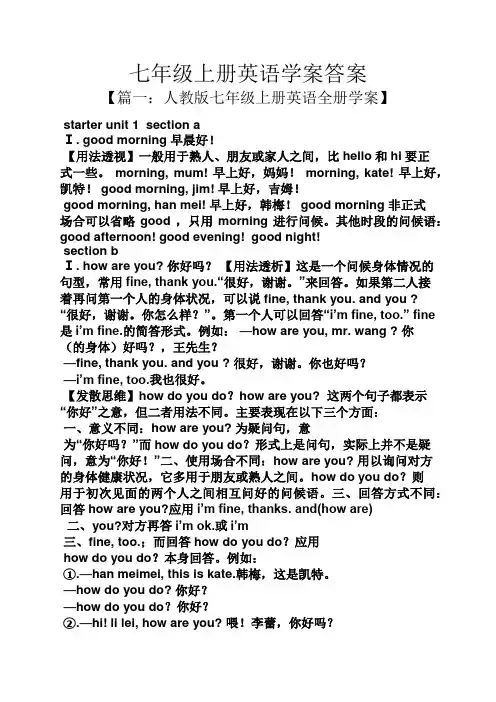
七年级上册英语学案答案【篇一:人教版七年级上册英语全册学案】starter unit 1 section aⅠ. good morning 早晨好!【用法透视】一般用于熟人、朋友或家人之间,比hello和hi要正式一些。
morning, mum! 早上好,妈妈!morning, kate! 早上好,凯特! good morning, jim! 早上好,吉姆!good morning, han mei! 早上好,韩梅! good morning 非正式场合可以省略 good ,只用 morning 进行问候。
其他时段的问候语:good afternoon! good evening! good night!section bⅠ. how are you? 你好吗?【用法透析】这是一个问候身体情况的句型,常用fine, thank you.“很好,谢谢。
”来回答。
如果第二人接着再问第一个人的身体状况,可以说fine, thank you. and you ? “很好,谢谢。
你怎么样?”。
第一个人可以回答“i’m fine, too.” fine 是i’m fine.的简答形式。
例如:—how are you, mr. wang ? 你(的身体)好吗?,王先生?—fine, thank you. and you ? 很好,谢谢。
你也好吗?—i’m fine, too.我也很好。
【发散思维】how do you do?how are you? 这两个句子都表示“你好”之意,但二者用法不同。
主要表现在以下三个方面:一、意义不同:how are you? 为疑问句,意为“你好吗?”而how do you do?形式上是问句,实际上并不是疑问,意为“你好!”二、使用场合不同:how are you? 用以询问对方的身体健康状况,它多用于朋友或熟人之间。
how do you do?则用于初次见面的两个人之间相互问好的问候语。
Unit4-SectionA(1a-1c)导学案人教版英语七年级上册
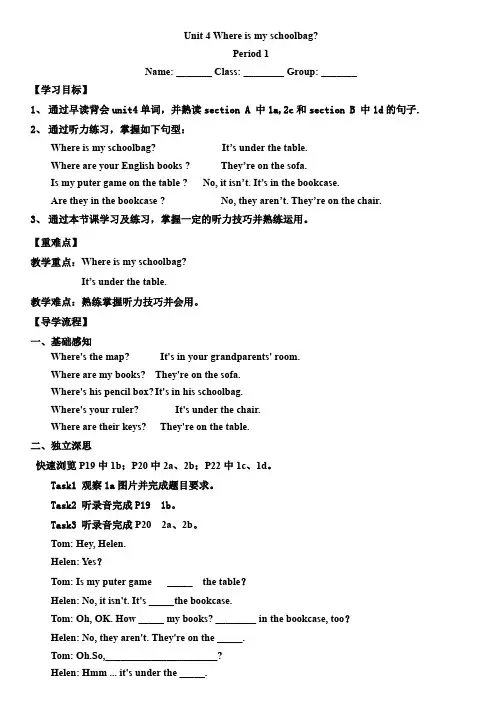
Unit 4 Where is my schoolbag?Period 1Name: _______ Class: ________ Group: _______【学习目标】1、通过早读背会unit4单词,并熟读section A 中1a,2c和section B 中1d的句子.2、通过听力练习,掌握如下句型:Where is my schoolbag? It’s under the table.Where are your English books ? They’re on the sofa.Is my puter game on the table ? No, it isn’t. It’s in the bookcase.Are they in the bookcase ? No, they aren’t. They’re on the chair.3、通过本节课学习及练习,掌握一定的听力技巧并熟练运用。
【重难点】教学重点:Where is my schoolbag?It’s under the table.教学难点:熟练掌握听力技巧并会用。
【导学流程】一、基础感知Where's the map? It's in your grandparents' room.Where are my books?They're on the sofa.Where's his pencil box?It's in his schoolbag.Where's your ruler?It's under the chair.Where are their keys?They're on the table.二、独立深思快速浏览P19中1b;P20中2a、2b;P22中1c、1d。
Task1 观察1a图片并完成题目要求。
Task2 听录音完成P19 1b。
七年级上册unit4教案三
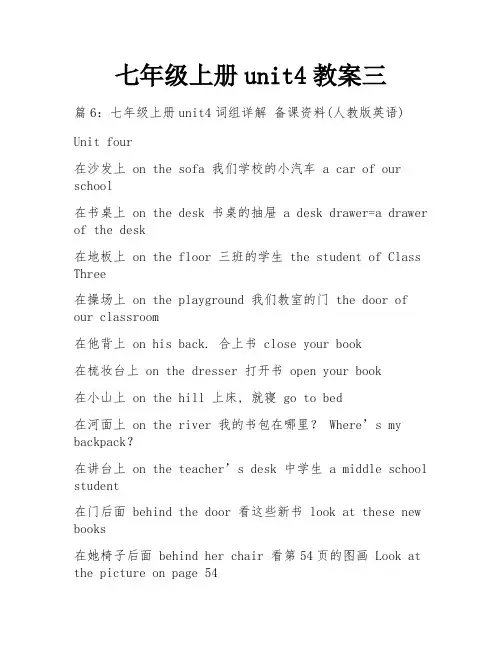
七年级上册unit4教案三篇6:七年级上册unit4词组详解备课资料(人教版英语)Unit four在沙发上 on the sofa 我们学校的小汽车 a car of our school在书桌上 on the desk 书桌的抽屉 a desk drawer=a drawer of the desk在地板上 on the floor 三班的学生 the student of Class Three在操场上 on the playground 我们教室的门 the door of our classroom在他背上 on his back. 合上书 close your book在梳妆台上 on the dresser 打开书 open your book在小山上 on the hill 上床, 就寝 go to bed在河面上 on the river 我的书包在哪里?Where’s my backpack?在讲台上on the teacher’s desk 中学生 a middle school student在门后面 behind the door 看这些新书 look at these new books在她椅子后面 behind her chair 看第54页的图画 Look at the picture on page 54在卧室里 in the bedroom 台灯 a desk lamp在抽屉里 in the drawer 录像带 video tape= video cassette []在书桌的抽屉里 in the desk drawer 这儿没有一只猫 There isn’t a cat here在厨房 in the kitchen 自行车上的男孩 the boy on the bike在这个房间里 in this room 树下的自行车 the bike under the tree在背包里 in the backpack 树上的小鸟 the bird in the tree在客厅 in the living room(美)门后的那只猫 the cat behind the doorin the sitting room(英)在绿色小汽车里的那个 the one in the green car在中国 in China 骑黑色自行车的那个 the one on the black bike在盒子里 in the box 照片上的人 the people in the picture在树底下 under the tree 报纸上的一幅图画 a picture in the newspaper在书橱里 in the bookcase 一个戴白色帽子的老人 an old man in a white hat在天空中 in the sky 一个穿蓝色毛衣的女人 a woman in a blue sweater在阳光下 in the sun 穿红色外套的那个 the one in the red coat带着帽子 in the hat 戴着红帽子的女孩 the girl in a red hat在桌子底下 under the table 穿红衣服的女孩 the girl in red(物体)在床上 be on the bed 我的包在床上 My bag is on the bed(人躺)在床上 be in bed 他躺在床上 He is in bed.在……的前面 in front of 房子的前面有棵树There’s a tree in front of the house在(物体内部)的前面 in the front of 教室的前面有块黑板There’s a blackboard in the front of the classroom在……中间 in the middle of 房间的中央有张桌子There’s a table in the middle of the room在树上(本身长的) on the tree 树上有一些苹果 There are some apples on the tree.在树上(外来的) in the tree 树上有一些鸟 There are some birds in the tree.在墙上(表面) on the wall 墙上有幅画 There is a picture on the wall在墙上(嵌进) in the wall 墙上有两个窗户 There are two windows in the wall.吃饭时 at table 进餐时别说话Don’t talk at ta ble.在桌子旁边 at the table 他坐在桌子旁 He is at the table.在门口 at the door 需要做某事 need to do sth (主语是人)靠近next to 需要做某事 need doing sth. (主语是物)靠近窗户 next to the window 我们需要乘车 we need to catch a bus在河边 beside the river 这些树需要浇水 The trees need watering在河边 near the river 我需要些帮助 I need some help.需要某物 need sth. 我需要我的数学书 I need my math book在…和…之间between…and… 球在床和书桌之间 The ball is between the bed and the desk.把……带来…… bring …to … 请把你妹妹带到学校来Please bring your sister to school .把……带去…… take …to … 请把棒球拿到教室去 Please take the baseball to the classroom.想要 would like=want 想做某事 want to do sth.=would like to do sth.想要一点儿咖啡 would like some coffee. 想要某人做某事want sb.to do sth =would like sb. to do sthDear Feifei,Please take these things to your sister: her hat, watch, notebook, keys and ID card. The hat is on the dresser. The watch is under the bed. The notebook is on the bed. The keys are in the drawer. The ID card is on the table.Thanks,GrandmaDear Chen Guang,Can you bring some things to school? I need my hat, my notebook, and a pen. My hat is on the chair, the notebook is on the floor, and my pen is on the table.Thanks,Chen Yang篇7:人教版七年级英语上册知识点必背典句:(1) Good morning, Alice! 早上好,艾丽斯!(2) Good afternoon! 下午好!(3) Hi, Bob! 你好,鲍勃!(4) Hello, Frank! 你好,弗兰克!(5) Good evening 晚上好!(6) —How are you? 你好吗?—I’m fine, thanks.How are you? 我很好,谢谢。
2022年 《仁爱英语七年级上册Unit4 单元学案》优秀教案
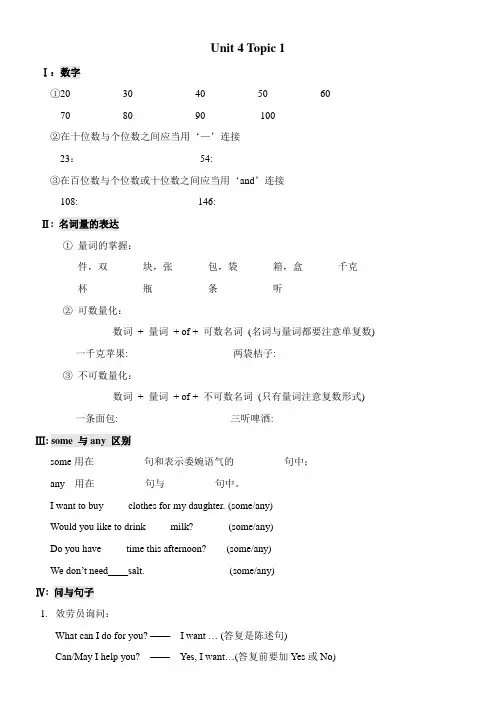
Unit 4 Topic 1Ⅰ:数字①20 ________ 30 ________ 40 ________ 50 ________ 60 ________70 ________ 80 ________ 90________ 100 ________②在十位数与个位数之间应当用‘—’连接23:____________________ 54: ____________________③在百位数与个位数或十位数之间应当用‘and’连接108:____________________ 146: ____________________Ⅱ: 名词量的表达①量词的掌握:件,双____ 块,张____ 包,袋____ 箱,盒____ 千克____杯____ 瓶____ 条____ 听____②可数量化:数词+ 量词+ of + 可数名词(名词与量词都要注意单复数) 一千克苹果:__________________ 两袋桔子: __________________③不可数量化:数词+ 量词+ of + 不可数名词(只有量词注意复数形式) 一条面包: __________________ 三听啤酒: __________________ Ⅲ: some 与any 区别some用在__________句和表示委婉语气的__________句中;any 用在__________句与__________句中。
I want to buy ____ clothes for my daughter. (some/any)Would you like to drink ____ milk? (some/any)Do you have ____ time this afternoon? (some/any)We don’t need____salt.(some/any)Ⅳ: 问与句子1.效劳员询问:What can I do for you? ——I want … (答复是陈述句)Can/May I help you? ——Yes, I want…(答复前要加Yes或No)? ——.我可以为你做什么?我想要买一双鞋。
仁爱版七年级上册英语第四单元学案全
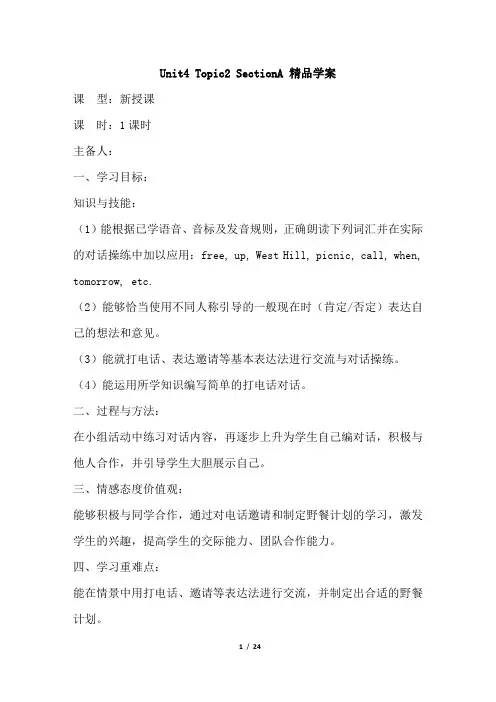
Unit4 Topic2 SectionA 精品学案课型:新授课课时:1课时主备人:一、学习目标:知识与技能:(1)能根据已学语音、音标及发音规则,正确朗读下列词汇并在实际的对话操练中加以应用:free, up, West Hill, picnic, call, when, tomorrow, etc.(2)能够恰当使用不同人称引导的一般现在时(肯定/否定)表达自己的想法和意见。
(3)能就打电话、表达邀请等基本表达法进行交流与对话操练。
(4)能运用所学知识编写简单的打电话对话。
二、过程与方法:在小组活动中练习对话内容,再逐步上升为学生自己编对话,积极与他人合作,并引导学生大胆展示自己。
三、情感态度价值观:能够积极与同学合作,通过对电话邀请和制定野餐计划的学习,激发学生的兴趣,提高学生的交际能力、团队合作能力。
四、学习重难点:能在情景中用打电话、邀请等表达法进行交流,并制定出合适的野餐计划。
I. 课前自主预习案一、过词汇、短语关(一)大声朗读Section A的单词(包括音标)和课文P89 1a 10分钟。
(二)在家听写Section A单词(英汉)(家长签字哦)。
(三)读1a,找出下列重点单词和短语,并在课文中勾画出来。
1) 我是……(电话用语)___________________2) 有空___________________3) 这个周末________________________4) 有什么事吗?____________________5) 你想/愿意做……吗?_____________________________6) I’d love to.________________7) go for a picnic________________________8) want to do sth. ______________________9) tell sb.about sth.___________________10) buy sth.for sb.___________________11) go shopping with sb.__________________二、阅读1、读1a 找出打电话的常用语言,并写在下面。
人教版七年级英语上册全册学案
人教版七年级英语上册全册学案第一篇范文:人教版初中英语七年级上册全套学案英语学科新目标人教版七年级上学期英语学案第1课时Unit 1 My name 's Gina (总第1课时)Section A 1a―2c【学习目标】:1、熟悉掌握词汇name clock 等2、学会介绍自己并询问他人姓名,能够利用所学知识进行打招呼.3、能听懂听力对话并能对根据听力对话进行自由交际.【学习重点】:使学生学会打招呼和介绍自己,并询问他人姓名的句型.Nice to meet you . What's your name ? My name is ......【学习过程】:一、自主学习(教师寄语:Knowledge is power.)学习任务一: 熟悉掌握词汇name ,clock1、认真观察第一页的图画,小组讨论你所认识的物品的英语单词. 2,、试着写出含有的物品的英语单词.3、小组竞赛,展示( 看谁总结的多, 写的准确)学习任务二: 学会介绍自己并询问他人姓名,能够利用所学知识进行打招呼.1、教师自我介绍,引导学生介绍自己.A: Hello , I am Gina , What's your name ?B: My name is Alan .2、小组竞赛, 两人一组,询问他人姓名,介绍自己.3,、分角色朗读1A对话.学习任务三: 能听懂听力对话并能对根据听力对话进行自由交际.1,、听录音, 给1B 的对话编号.2、根据听力对话进行自由交际.3、小组竞赛, 展示对话交际。
二、合作共建(教师寄语:Many hands make light work. )小组讨论我们所学的英语名字和汉语名字的区别, 如何用英语拼写你的名字?三、系统总结(教师寄语:No man can do two things at once.)1,、归纳你所学到的问候语.2、自己编写一个打招呼并询问姓名的小对话.四、诊断评价(一)单项选择.1. _______your name ? My name is Gina .A. WhatB. What'sC. WhoD. which2. Good morning , Miss Wang ! _____________!A. HelloB.HiC. Nice to meet youD. Good morning3. I _______Sally , What______ your name ?A. am ,isB. is , amC. is , isD.am, am4. ______name is Li lei .A. IB. I amC. MyD. you5.― _______, What's your name ?― John Green .A. HiB. OkC. sorryD. Excuse me(二)写出下列单词的完全形式, 并写出汉语意思.I'm _________ __________ what's __________ ________name 's ___________ __________(三)写出下列单词.时钟_______ 我的________ 你的___________ 名字_______ 遇见_________(四)尝试翻译下列句子.1. 见到你很高兴. _________________________________.2.我叫王小雨. ____________________________________.3. 你叫什么名字? ____________________________________(五)根据情景补全对话.A: Good afternoon !B: ____________________!A; I ______Lucy . _________your name ?B: My ______ is Jim . Nice to ______you !A: _______________________________.五、【课后反思】(教师寄语:Never do things by halves)第2课时Unit 1 My name 's Gina.(总第2课时)Section A (1a―2c)【学习目标】:1、熟练掌握本课6个单词.2、学会询问他人姓名及介绍他人姓名.3、能听懂有关谈论他人姓名的对话并进行自由交际. 【学习重点】:询问他人姓名及介绍他人姓名的句型. 一、自主学习(教师寄语:Knowledge is power.)学习任务一: 熟练读写本课6个单词.1.个人自渎,记忆本课单词.2.小组互相检查单词读写情况.3.根据汉语写出下列英语单词并展示.学习任务二: 运用句型:What's his / her name?His / Her name is .... 进行自由交际.1.小组合作,理解并熟读下列短语,并写出汉语意思.my nane ( )your name ( )his name ( )her name ( )2.个人理解下列对话,并且两人合作练习.A:Hello! What's your name?B:My name is Gina.A:Nice to meet you.B:Nice to meet you,too.A:What's her name?B:Her name is Jenny.3.小组合作,练习自己的对话.4. 对抗组开展竞赛,展示自己的对话.学习任务三: 听听力完成2a,2b.1.个人看图,理解四幅图画,思考图画中人是在谈论他人还是对方.2.听听力,给四幅图画编号.3. 小组为单位,熟读2b中的名字。
【人教版】2017-2018学年七年级英语上册:全一册学案(含答案)
【⼈教版】2017-2018学年七年级英语上册:全⼀册学案(含答案)Starter Unit 1 Good morning!Period One学习⽬标1.掌握字母表中的前8个字母:Aa,Bb,Cc,Dd,Ee,Ff,Gg,Hh2.掌握8个⼈名:快乐⾃学1.我懂得早上见⾯打招呼的句型了。
2. I can read .(我会读)我会跟着磁带⼤声朗读1a中的句⼦。
3. I can write .(我会写)我会⽤拼⾳写我⾃⼰的名字了合作探究⼩组讨论:1.英语中字母的⼤⼩写在格式、笔画等⽅⾯应注意哪些?2.在⽇常⽣活中,遇到过哪些英⽂字母?课堂⼩结这节课我学会了:1.问候的句⼦2.怎样写⾃⼰的英⽂名字达标检测I.写出下列字母的左邻右舍b E g C D f II..你认识下⾯名字吗?将它们搭配在⼀起1.Alice2.Helen3.Bob4.Frank5.Cindy6.Dale7.GraceB.艾丽斯C.海伦D.⾟迪E.弗兰克F.埃⾥克G.格雷丝H.鲍勃III.从II栏中找出与I栏相应的答句I II( )1.Good morning! A.Good evening! ( )2.Hi, Ann! B.Good morning!( )3.Good afternoon! C.Hi, Tom! ( )4.Good evening! D.Good afternoon! IV.补全对话1.-________________, Helen!-Good morning, Cindy!2.-Hi, Bob.-________________, Alice.3.-Good evening!-_______________!V.单项选择( )1.早上或上午见⾯说:“_______”A.Good morning!B.Good afternoon!C.Good evening!( )2.熟⼈之间打招呼时应说:“_______”A.Hi!B.Good morning!C.Good afternoon!( )3.傍晚遇见你的好朋友说:“_______”A.Good morning!B.Hi!C.Good evening!B.Good morning, Eric!C.Good evening, Eric! 学习反思答案:I. a b c D E F f g h B C D C D E e f gII.1-8. BCHEDAGFIII.1-4.BCDAIV.1. Good morning2.Hello/Hi3. Good eveningV.1-4.AACAStarter Unit 1 Good morning!Period Two学习⽬标1.掌握字母表中的前8个字母:Aa ,Bb ,Cc ,Dd ,Ee ,Ff ,Gg ,Hh2.掌握3个新单词:HB ,CD ,BBC快乐⾃学1. I can listen .(我会听)我会听录⾳并跟读2a2. I can finish .(我会完成)我能根据2b 听录⾳,根据所听到的顺序为字母编号。
人教版七年级英语上册教案 Unit 4 第2课时 Section A (2a-2d)
第二课时SectionA (2a-2d)Step1 完成教材2a-2c的任务【操作案例】1.让学生用英语说出2a中的物品,然后两人一组互相提问单词,为听力做好准备。
2.听录音,按听到的顺序为物品编号,集体核对答案。
3.认真观察2b中的图片,再听一遍录音,在2b中找出2a中的物品,并为他们编号,小组内核对答案,教师展示答案。
4.两人一组,就2b中物品的位置,仿照2c的形式来练习对话,并邀请几个学生表演对话。
设计意图:通过听、说训练让学生掌握了方位介词短语的用法,同时学生的口语表达水平在对话练习中得到提升。
Step2 完成教材2d的任务【操作案例】1.学生快速阅读对话,了解对话大意,回答下面的问题:Where'sJack'shat?2.学生认真自读对话,找出对话中表示方位的介词短语,完成后小组成员之间互相交流,然后两人一组互相提问短语。
3.大声朗读2d对话,读熟后与同伴结对练习,分角色表演对话。
4.邀请三组学生来表演对话。
5.小结训练。
( A )(1)—Where'syourpen?—________.A.Onthetable B.Yes,it'sonthetableC.No,it'sniceD.Yes,theyare( B )(2)—Wherearethe________?—________onthetable.A.key;They'reB.keys;They'reC.key;It'sD.keys;It's( C )(3)—Areyourrulersinyourpencilbox?—________.A.Yes,theyaren'tB.No,itisn'tC.Yes,theyareD.No,theyare设计意图:本环节的学习,既能锻炼学生的口语表达能力又对所学的介词短语和询问物体的位置的句型起到复习巩固的作用。
七年级英语上册 Unit4 Where is my backpack同步学案 新目标
新目标七年级英语上同步学案Unit4 Where is my backpack?一、单词导航台1.bed/bed/ n. 床【考点】go to bed睡觉;make the bed整理床铺;be ill in bed生病卧床:Tom has been ill in bed for a month. 汤姆生病卧床一个月了。
in bed的意思是“(在)睡觉,卧床”;bed前无冠词。
get(jump) out of bed下床;put…to bed安顿睡觉。
【引申】bunk bed(小孩用的)上下铺;camp bed行军床;double bed双人床;water bed水床;bedroom卧室。
2.Drawer n. 抽屉3.next/nekst/ adj. (无比较级或最高级)最近的,紧挨的,隔壁的:Don’t worry, we can take the next bus. 别着急,我们可以搭下一班车。
adv. 随后,下一步:What should we do next?我们接下来应该怎么做?【记忆法】next, text(课文)联合记忆。
【考点】next没有比较级或最高级。
next door在隔壁:He lives next door. 他住在隔壁。
【引申】next to none adj. 不比任何人差的;next time下一次。
4. on prep. ①在……之上:Your book is on the table. 你的书在桌上。
②附近,靠近:He sat on my right. 他坐在我的右边。
③在……的时候:I get up at eight o’clock on Sundays. 我在星期天时八点起床。
④关于:He gave us a lecture on how to learn. 他给我们做了有关如何学习的报告。
adv. ①在……上:The tablecloth is not on. 桌布没放上。
- 1、下载文档前请自行甄别文档内容的完整性,平台不提供额外的编辑、内容补充、找答案等附加服务。
- 2、"仅部分预览"的文档,不可在线预览部分如存在完整性等问题,可反馈申请退款(可完整预览的文档不适用该条件!)。
- 3、如文档侵犯您的权益,请联系客服反馈,我们会尽快为您处理(人工客服工作时间:9:00-18:30)。
七年级英语上学案4
名词(三)
名词或代词作主语时和谓语之间的单复数的一致问题:
1、谓语和谓语基本保持单复数的一致,即:主语是可数名词单数或不可数名词时,谓语动词用单数形式:如:The computer was a great invention.(计算机是个了不起的发明)The water in the glass is very cold.(玻璃杯里的水很冷)
2、集体名词(如family, class, team, group, row, police, school等)做句子主语时,
如果表示整体概念,则谓语用单数形式,如:Class Three is a very good class.(三班是好班)
如果表示其中的所有成员时,则谓语用复数形式,如:Class Three have a map of China.(三
班有张中国地图)
3、Chinese, Japanese, fish, sheep, people等表示单个时谓语用单数,表示许多时,谓语用复数。
如:There is a sheep in the yard.(院子里有只绵羊) / There are some sheep in the yard.(院子里有一些绵羊)
4、maths, news等虽然有s结尾,但不是复数,因此谓语仍用单数:The news is very exciting. (这个消息令人兴奋)
5、glasses, shoes, socks, trousers, gloves等名词往往用复数形式,故谓语用复数。
如:
The trousers are very cheap and I want to take them.(裤子很便宜,我想买)
6、a lot of 后跟名词复数时谓语用复数形式,跟不可数名词时谓语用单数形式。
如:A lot of students are playing baseball now.(现在有许多学生在打垒球) A lot of time was wasted on that work.(大量的时间花在了那个工作上)(被动句)
7、and 连接两个名词做主语时,谓语原则上用复数,但是两个名词若构成一个整体事物时,谓语则用单数。
如:The teacher and his son are picking apples now.(老师和他的儿子在摘苹果) / Fish and chips is very famous food. (鱼和薯条是一种出名的食品)
8、there be 句型中be的单复数一般由靠近的名词决定,也叫就近原则。
如:There is a table and four chairs in the room.(房间里有一张桌子和四张椅子)
9、用both…and…连接两个事物做主语时,谓语一般用复数。
如:Both you and I are required to be here tomorrow.(你和我明天要求都来)
10、主语中含有with的短语时,谓语单复数由with之前的人物决定。
如:A woman with a
7-year-old child was standing at the side of the road. (一名妇女带着一个七岁的孩子(当时)就站在路边)
11、either…or…或者neither…nor…连接两个人物做句子主语时,谓语采用就近原则。
如:Either you or he is right.(要么是你对,要么是他对。
/你和他有一个人是对的) / Neither you nor
I am going there.(你和我都不打算去那里)
12、表示一段时间或长度概念的复数名词做主语时,谓语一般用单数。
如:Two months is not
a short time.(两个月不是个短时间)Two thousand kilometers is quite a long distance(距离).(两千千米是相当长的一段距离)
单词练习
香蕉伟大的篮球think
汉堡包飞机听起来迟到
西红柿love 同班同学运动
Ice-cream 谢谢teacher 外婆
沙拉女儿电脑图书馆
草莓uncle 图片打电话
pear 早餐lunch 明星;星星吃好、令人满意地习惯健康的
牛奶面包生日十一
十二十三fourteen 十五
十六十七十八十九
二十三十短袜男衬衣;衬衫T恤衫短裤sweater 裤子
鞋裙子多少钱全部
中英互译
1、牛奶对身体健康有好处。
2、早餐和午餐是很重要的。
3、这个面包很好吃。
4、China is a great country, and Chinese are friendly.
5、There are different kinds of fishes in the pond.
6、数学很容易。
7、妈妈包里有一部手机、两只铅笔、一个本子。
8、我们学校有两栋教学楼、一个操场。
9、The trousers ar e nice, how much are they?
10、Chocolate and ice-cream is delicious.
11、房间里有一张床、两个凳子。
12、我和我爸妈都是老师。
13、A grandmother with a basket of apples was waiting for you.
阅读理解
Bob and Jim once worked in the same factory. One day, Bob lent Jim ten dollars, but then Jim left his work and went to work in another town without paying back the money.
Bob didn't see Jim for a year, and then he knew from another friend that Jim was in another town and staying at a hotel. So he went there to see him late in the evening.
When he got to Jim's room, he saw his shoes near the door. "Well, he must be in," he thought, and knocked again, and said, "I know you are in, Jim. Your shoes are out here."
"I've gone out in my boots," answered Jim.
True or False
1. Bob and Jim once worked in different factories.
2. One day Jim borrowed ten dollars from Bob.
3. Jim paid back the money to Bob and went to work in another town later.
4. Bob hadn't seen Jim for a year when he learned that Jim was in another town.。
